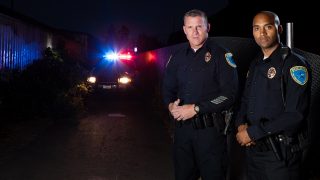
Defunding the police (DTP) surfaced in the summer of 2020 following the deaths of George Floyd, Breonna Taylor and others. DTP is a slogan that supports removing funds from police departments and reallocating them to non-policing forms of community support, such as social services, youth services, housing, education, health care and other community needs.
Proponents of DTP say it is time to invest in our communities, not policing. Law enforcement saw itself being attacked by the “progressive left” and then by the “extreme right” prior to and at the time of the January 6th insurrection. While the motivations might have been different, the result was to blame the police for society’s failings.
America is renowned for its commitment to short-term fixes and knee-jerk responses to problems.
America is renowned for its commitment to short-term fixes and knee-jerk responses to problems. Whether it is on the international stage or in our local neighborhood, having a strategic vision and plan for change or a new vision for comprehensive local community services rarely exists.
DTP tends to stereotype all police, believing that all police agencies operate in the exact same way. Policing in metropolitan, suburban and small/rural communities are vastly different venues. Staffing, budgets, training and outreach programs are as varied as the personalities of the 18,000 police chiefs and sheriffs across the country who operate in different political environments.
According to the International Association of Chiefs of Police (IACP), 71% of U.S. police agencies serve populations with fewer than 10,000 residents. The average-sized police agency in the U.S. totals just 25 officers.
Policing absorbs the weight of society’s failures
When communities lack resources, then inevitably, the police are called because we make house calls. Beginning in the 1960s, state mental institutions began to close due to a lack of quality care. The neighborhood mental health centers, promised by President Kennedy prior to his assassination, never materialized. The closure of state institutions turned thousands with mental health problems onto the streets of America. The result has been the criminalization of those with mental health issues for the past half century, placing crisis intervention at the feet of law enforcement. Society simply failed to invest in mental health care.
Here are two different models to consider. Crisis Assistance Helping Out On The Streets (CAHOOTS) is a mobile crisis intervention program staffed by White Bird Clinic personnel in Eugene, Oregon. Its vans are staffed with a medic (nurse or EMT) and an experienced crisis worker.
CAHOOTS provides support for police personnel by taking on many of the social service calls for service to include crisis counseling being dispatched through the 9-1-1 center. They provide initial contact and transport for people who are intoxicated, mentally ill or disoriented, as well as transport for necessary non-emergency medical care.
Another option is the firehouse model. The fire service provides a natural resource that could stand-up crisis response teams. Since 2021, the fire service has been identified by local leaders and fire executives as a resource to shift responsibility for mental and behavioral health calls. These are health calls, and the fire service adopted emergency medical responses over a half-century ago.
What these or other models would look like or how they would be funded have too often been placed on the back burner. The responsibilities for homelessness, emergency food distribution, shelter services or emergency motel vouchers, as well as a lengthy list of other non-police functions, have crept into the core duties of many police agencies. Community agencies have failed at their job or have failed to secure funding and staffing, relying instead upon the police to respond.
There are many examples of cities, counties and states that have for years been defunding housing, health care, job programs, libraries, arts and culture, and violence-prevention programs. In some cases, social services have been privatized. More than 20 years ago, Governor Bill Graves (Kansas) took the first steps to dismantle government services in support of corporate privatization. The state further dismantled state systems with outsourcing by Governor Sam Brownback (Kansas) in 2013. It will take years for Kansas to meet quality service expectations for children and families, even with the investments made beginning in 2018 by the current governor, Laura Kelly.
Reducing police staff is a false target
According to Gallup polls, nearly three in four Americans (74%) in 2021 said they were confident in their local police. In the 2022 Gallup Global Law and Order Report, 81% of Americans reported having confidence in their police.
The concept of reducing policing presence certainly did not need the extra push from the DTP movement. The nationwide challenge of recruiting and retaining law enforcement staff has constricted patrol, investigations and outreach efforts since before COVID hit.
Reduced policing, combined with a handful of DTP efforts, such as Seattle, Minneapolis, Austin, Portland and a dozen other major cities reduced police staffing. A few cities removed officers from schools. Some of these cities are now refunding and expanding police funding after crime increases.
An ABC TV survey examined the budgets of more than 100 cities and counties and found that 83% are spending at least 2% more on police in 2022 than in 2019. Of the 109 budgets analyzed, only eight agencies cut police funds by more than 2%, while 91 agencies increased law enforcement funding by at least 2%. In 49 cities or counties, police funding has increased by more than 10%.
DTP is a miscalculation
The discussion about funding should not be an either/or debate. There should be funding for both (police, fire and EMS), as well as mental health services, social services and helping agencies. That will require cities, counties and state governments to refocus their funding priorities. The federal government will have to lead these efforts.
In the past few years, nearly 150 policy recommendations, law changes, best practices and presidential executive orders have targeted police reform (see the list at tinyurl.com/2zszpz4m). It is far too soon to abandon the progress police agencies have made in their evolution.
Myths of DTP versus facts
Defund means abolish. There is a continuum of what defunding means to various groups and individuals. It is shortsighted to propose an either/or approach. Some point to the demilitarization of the police as a goal. Yet, law enforcement has merely been reactive to the growing militarization of felons, gangs and criminals. There should be no reallocation of funds for mental health workers and social workers but an increase in funding for these critical needs.
Defunding will lead to disorder. DTP advocates state that it is a misconception that the police maintain order. Wrong. Police respond to calls for help and assistance. Proactive policing and community outreach programs have been whittled away by the recruiting and retention challenges. Establishing a peaceful society requires years of new investment in education, infrastructure and social programming, not a quick knee-jerk police-defunding effort.
Police don’t protect the public from violence. We need trained and competent police who are guardians to respond to violence. Solving crime is not just a police responsibility it is a joint responsibility of citizens collaborating with the police.
Community programs won’t work. Police officials agree that policing alone cannot eliminate crime. You cannot arrest communities out of crime without communities investing in, developing and supporting education and economic programs.
Most police work is focused on crime prevention. DTP advocates confuse police surveillance with stop-and-frisk programs. Crime prevention requires community partners and outreach efforts for effective policing. Yet, staff reductions due to early retirements, recruiting challenges and the effects of the pandemic have cut prevention efforts and investigative resources.
Police reform is long overdue as the profession slides away from community-oriented policing into the era of homeland defense after 9/11. As a profession, we missed opportunities to make appropriate changes. In 2020, the murder of George Floyd was a trigger that garnered national attention and caused many to take a long, hard look at our policing systems and over-policing that cast a shadow on equal protection.
No matter what we choose to call it — defunding the police, reinventing the police, funding the police and social services — it is time to have a strategic vision for communities. Police accountability and transparency and the marketing of police services, performance and resources must be the norm.
As seen in the February 2023 issue of American Police Beat magazine.
Don’t miss out on another issue today! Click below:






